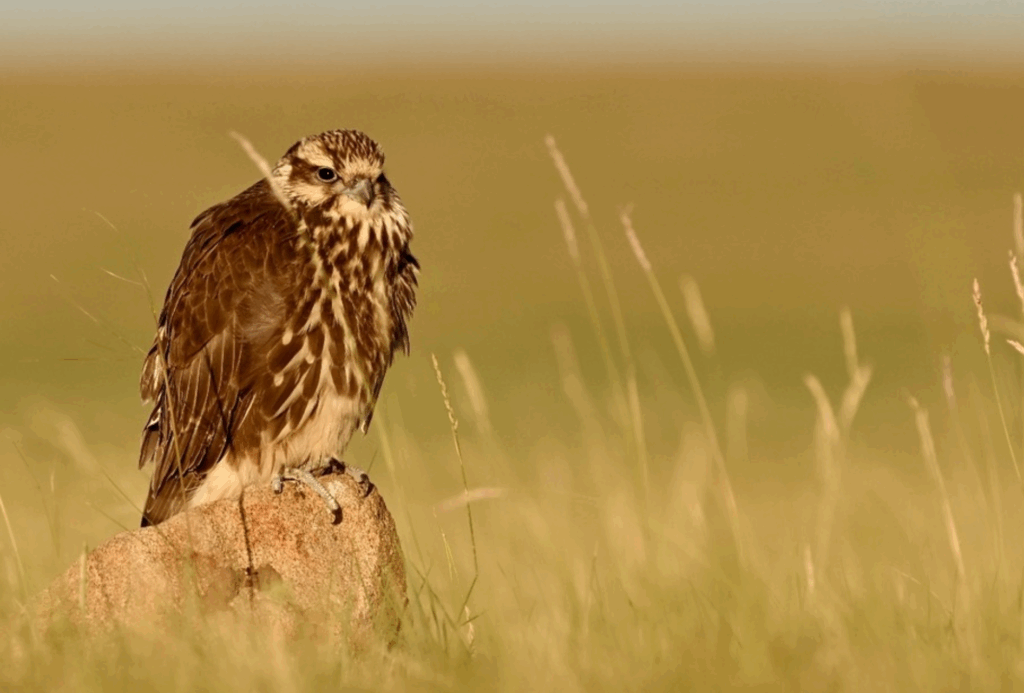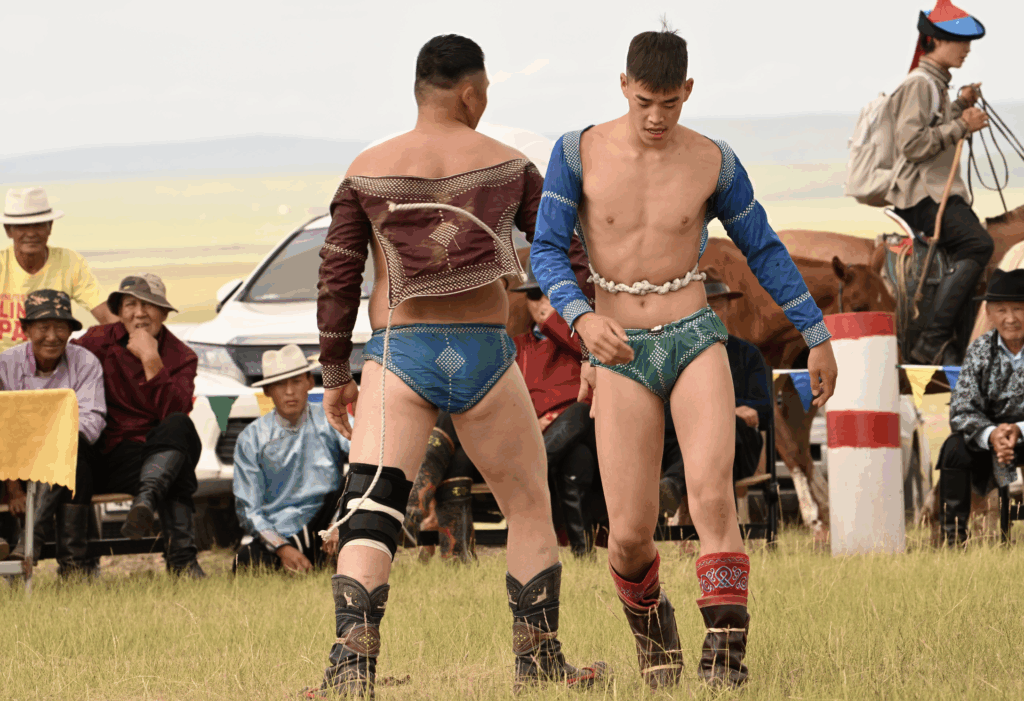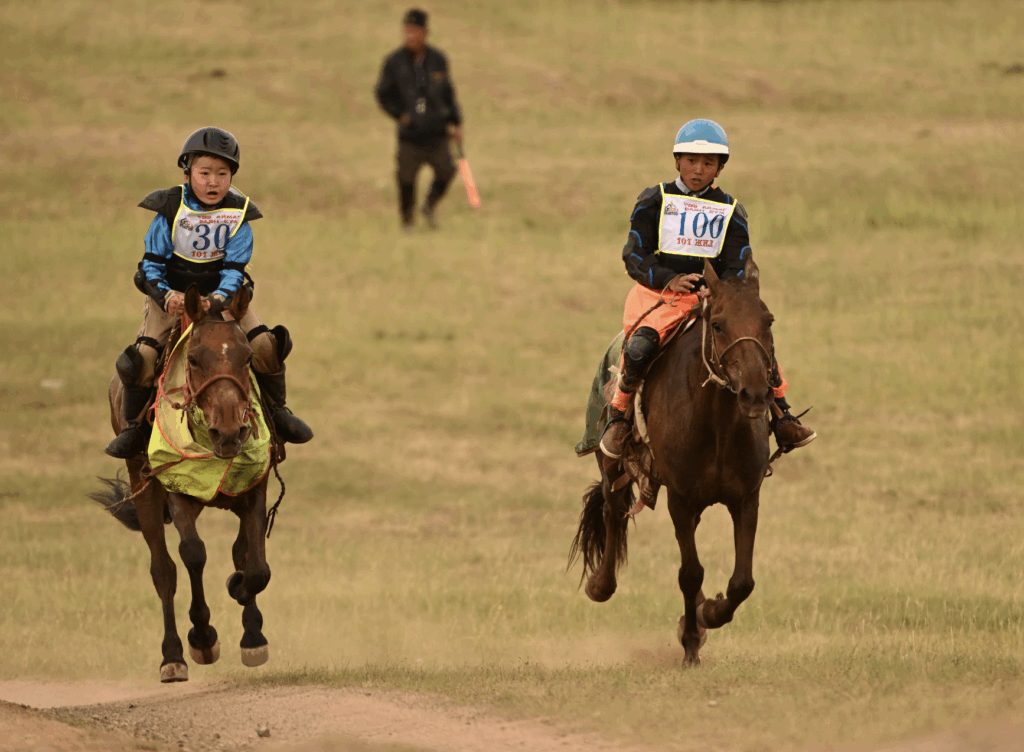After a week on the ground, I can tell you it’s unlike anything I’ve witnessed in thirty years of conservation work
The sun is just breaking over the steppes when we spot him. Simon—that’s what we’ve named this young Saker Falcon—sits perfectly still on a weathered rock, his radio tag catching the morning light. I’m crouched maybe ten feet away, trying not to breathe too loudly. My heart is hammering, but not from the cold. It’s from the weight of what this moment represents.

I’m in Mongolia with my colleague Kiran Ghadge on a mission for the Mohamed bin Zayed Raptor Conservation Fund, documenting one of conservation’s most remarkable success stories. The Saker Falcon is Mongolia’s national bird, but it’s also a national symbol in the UAE—a connection that bridges two cultures united by their reverence for this magnificent raptor. In partnership with Voices from The Roof of the World, we’re making a documentary about our decade-plus-long project here. We’re calling it Saker Skies, and after a week on the ground, I can tell you it’s unlike anything I’ve witnessed in thirty years of conservation work. The numbers tell part of the story: 27,000 retrofitted power poles, 5,000 artificial nests, more than 25,000 fledged Saker Falcons over the past thirteen years. But numbers don’t capture the moment when a Mongolian herder gallops up on horseback, grinning as he points to the nest box he helped install. Numbers don’t explain why my throat tightened when I watched a young student named Oggie hold my camera for the first time, his eyes wide as he tracked a falcon overhead.
When I landed in Ulaanbaatar on about a week ago, the familiar chaos of the city hit me—traffic, construction, the eternal dance of old and new. Aaggii from the Mongolian Bird Conservation Center picked me up, and we drove through streets lined with Soviet-era buildings and gleaming new shopping centers. He is young, brilliant, and completely devoted to these birds. As we navigated the notorious traffic, he told me about his current research, his voice carrying that particular excitement scientists get when they’re onto something important.
Kiran arrived that evening, his bags somewhere in airline limbo but his enthusiasm intact. We hadn’t worked together in seven years, but sitting around that dinner table with our colleagues Huyaaga and Amaraa, it felt like no time had passed. We spread maps across the table, plotted our route, and talked until late about the story we’d come to tell.
The next morning, we headed east into what locals call “raptor country.” Our base camp in Bayandelger is beautifully simple—two traditional gers, a wooden field station designed by MBZRCF Science and Conservation Director Dr Andrew Dixon, and a communal kitchen where everyone gathers. There’s something magical about this place. Students and researchers from around the world work side by side, sharing meals of mutton stew and salty tea. Even a French cyclist, pedaling from Beijing to Paris, stopped by and stayed for a few days, drawn by the shared sense of purpose.
From here, we follow the birds. We track fledglings tagged with satellite transmitters, document their hunting behavior, and watch them navigate this vast landscape. There’s Buddy, the camp’s resident raven who’s appointed himself our unofficial mascot. He’s mischievous and clever, stealing anything shiny and seemingly posing for our cameras. Then there’s Gigi, a rodent researcher studying what she calls the “landscape of fear”—mapping how Brandt’s voles, the Sakers’ primary prey, respond to predation pressure. Her work is meticulous, crucial, and helps us understand the intricate web that keeps these raptors alive.

But the science is only half the story. The heart comes from the people.
We spent a day at Gun Galot Nature Reserve with herders who’ve become conservation partners. With support from an organization called Sarana, they’ve erected artificial nests and now see Sakers not just as birds, but as allies in controlling rodent populations. One herder invited us to his family’s ger, where his wife prepared khor khog—traditional lamb stew cooked with hot stones heated in a fire until they’re white-hot, then dropped into a sealed pot with meat and vegetables. The stones cook the meat from the inside while the pot cooks it from the outside. It’s a meal that takes hours to prepare and minutes to disappear, shared around a low table while stories are exchanged and bonds are forged.
Our timing couldn’t have been better. We arrived during Naadam, Mongolia’s most important festival, celebrating what they call “the three games of men”—wrestling, archery, and horse racing. But calling it a festival doesn’t capture the magnitude. It’s a celebration of identity, of what it means to be Mongolian.
The wrestling matches are unlike anything in the West. Wrestlers wear traditional outfits—tight shorts, an open-fronted jacket that leaves the chest bare, and pointed boots. There are no weight classes, no time limits. Some matches last minutes, others go on for what feels like hours. The crowd doesn’t just watch—they participate, shouting encouragement, analyzing technique, celebrating not just victory but skill and honor.

Between the main events, children gather in circles playing shagai—a traditional game using ankle bones from sheep or goats. Each bone represents a different animal depending on how it lands, and kids flick them at each other’s bones, trying to knock them over. The concentration on their faces is intense, the same focus I see in young researchers tracking falcons. It’s a game that’s been played for centuries, teaching precision and patience.
But the horse races are something else entirely. These aren’t gentle trots around a track. Children as young as five race horses across 15 to 30 kilometers of open steppe, depending on the horses’ age. The finish line is chaos—horses and riders thundering in from the horizon, dust clouds billowing, families screaming for their children. Winning isn’t just about speed; it’s about the bond between horse and rider, something that runs deeper than training or technique.

Watching Naadam while working on this project felt like witnessing the cultural foundation that makes conservation possible here. The same people who celebrate these traditions are the ones protecting Saker Falcons. The same values—respect for nature, understanding of animals, pride in heritage—drive both.
Yesterday, we climbed a ridge beside a small Buddhist monastery to capture the landscape at golden hour. Below us, horses ran free across grassland that stretched to the horizon. Above, Saker Falcons and Cinereous Vultures rode the thermals. I watched Oggie, one of the young researchers, carefully cradle my heavy Nikon lens, his eyes scanning the sky for birds. In that moment, I realized this project isn’t just about saving Sakers. It’s about nurturing something deeper: the next generation of people who will care. And that is one of the pillars of the Mohamed bin Zayed Raptor Conservation Fund.
Each day here delivers moments that take your breath away. Installing nest cameras while falcons circle overhead. Flying drones over those remaining killer poles that we will eventually retrofit so that power lines will no longer kill birds. Capturing time-lapse footage of thunderclouds rolling over sacred hills. Photographing falcons in flight at dawn, their wings catching light that seems to come from another world.
But what truly gave me goose bumps was filming and interviewing the scientists. Their passion is infectious, their eyes lighting up when they talk about their work. Gigi describing her rodent research with such intensity that you can feel her excitement about every vole burrow she’s mapped. Amaraa explaining power line retrofitting with the fervor of someone who’s seen too many birds die needlessly and is determined to stop it. Aagii discussing his tracking and artificial nest programs with a gleam in his eye that says he knows exactly how many lives he’s saving. These are the voices that make this story sing.
But it’s the quiet moments that stay with you. Simon on his rock, alert and healthy. A herder’s wife smiling as she serves tea. A young student’s face lighting up when he spots his first Saker through binoculars. These are the moments that remind you why this work matters.
As we continue filming and documenting, I keep thinking about connection. Between birds and herders. Between science and tradition. Between the vast steppe and a small metal band on a falcon’s leg that says: you were seen, you mattered, you belonged here.
This is only the beginning of our story. But already, I know it’s one the world needs to hear.





Leave a reply